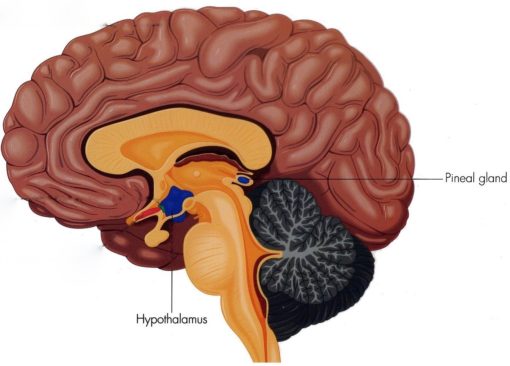Millions of Americans are desperate for a good night’s sleep. When insomnia persists for long enough, it’s common to reach for an over-the-counter sleep aid like Unisom, Zzzquil, or Tylenol/Advil PM. All of these medications include diphenhydramine, an antihistamine that’s also used in allergy medications like Benadryl. If you’ve ever taken diphenhydramine for allergies and found yourself falling asleep at your desk, you were experiencing the sedating effects of this medication.
Melatonin is another OTC medication that’s commonly taken for problems sleeping. Many of the people who come to my office for insomnia treatment are on melatonin, which is consistent with the fact that it doesn’t tend to be a very effective treatment for insomnia. The most recent review of studies in this area found that melatonin supplements led to about 8 minutes additional sleep per night—not nothing, but not a dramatic effect. To understand why, let’s consider what melatonin is and how it’s related to sleep.
What Is Melatonin?
 Melatonin is a hormone produced by the pineal gland, a small structure sitting on top of the brainstem at the midline of the brain (see image).
Melatonin is a hormone produced by the pineal gland, a small structure sitting on top of the brainstem at the midline of the brain (see image).
The pineal gland receives signals from a center within the hypothalamus that regulates our circadian rhythm, the 24-hour cycle of sleeping, waking, and other activities. It’s thanks to our circadian (“about a day”) cycle that we can fall asleep and wake up about the same time each day, aligned with the period of light and the majority of humanity (assuming no sleep problems).
[Exercise Improves Sleep, but Maybe Not How You Think on PsychologyToday.com]
It’s easy to see that melatonin is involved in sleep based on when it’s released: Following a circadian pattern, very little melatonin is released during the daytime, with concentrations rising in the evening a few hours before bedtime. Melatonin levels peak in the middle of the night, and fall to their daytime lows as we approach our wakeup time.
Given the increase in melatonin as sleep approaches, it’s reasonable to expect that taking extra melatonin would facilitate sleep. So why only 8 minutes of benefit, especially with the whopping doses (often 5-10 mg/night) typically sold in drug stores in the US?
Role of Melatonin in Sleep
In humans, who typically sleep at night, melatonin levels rise at night. In rodents and other vertebrates that are typically active at night, melatonin levels also rise at night. That’s right: The same hormone is linked to opposite patterns of behavior, depending on the species.
For example, in one cutting edge study the researchers measured melatonin levels continuously in mice, and found a strong connection between higher melatonin levels and greater “locomotion.” (For a review on the physiological effects of melatonin, see this article.)
So it seems that the real role of melatonin is to send a signal for “nighttime appropriate behavior.” If you’re a human or other diurnal species, that signal will mean “go to sleep.” For a mouse, that same signal means to run into your kitchen and forage for food. If you’re someone with really bad insomnia, it might simply feed into “lie in bed and stare at the ceiling, praying for sleep.”
No wonder melatonin doesn’t tend to be a great sedative, because that’s not its role. It’s not like an antihistamine or a benzodiazepine that have inherently tranquilizing effects. Instead the role of melatonin is to align our internal clocks with external demands, particularly those that depend on the light/dark schedule.
Recommended Treatments
In light of (no pun intended) the limited evidence for melatonin’s effectiveness as a sleep aid, current clinical guidelines recommend against its use in the treatment of chronic insomnia. These guidelines list other types of medication (e.g., zolpidem and eszopiclone) that may be better options based on their demonstrated efficacy, and suggest an order in which they be tried.
[The Most Important Way to Fight Insomnia on PsychologyToday.com]
The guidelines also recommend that any medication approach be paired with a treatment like cognitive behavioral therapy for insomnia (CBT-I). While medications can be as effective as CBT-I for some individuals, CBT-I has a better track record for helping in the long term, even without medication. I’ve written about the basics of CBT-I, which you can read here: How to Fix Broken Sleep.
Unfortunately the best therapies are often the hardest to find. If you don’t live close to a big city, there’s a good chance you won’t find anyone nearby who offers CBT-I. Fortunately there are other options available so you can still have the benefit of this treatment.
One option is to use a CBT-I app. One of the benefits of an app is that it can streamline the data collection and analysis part of the treatment. While I can’t personally vouch for any of these applications, you can read about some of the options that are available in this review.
There are also books available that present CBT-I, such as End the Insomnia Struggle and Quiet Your Mind and Get to Sleep, among others.
So while melatonin won’t cure most people’s insomnia, there are other options that can be very effective, and in the case of CBT-I involve no medications or related side effects. If you’ve considered treatment for insomnia, now might be a good time to look into it. Better sleep helps with pretty much everything.

